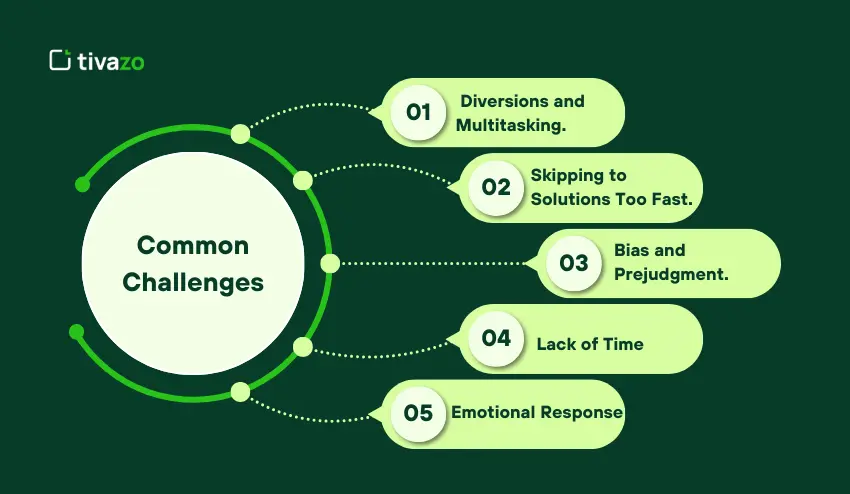Imagine this: you are at a meeting, presenting an idea that you have been polishing over weeks. After you are done talking, the leader in the room nods and moves on to the next agenda item. Not one question, not even one clarification, not even recognition. How would you feel? Frustrated? Overlooked? Perhaps even less incentivized to donate in the future?
That very situation occurs in millions of workplaces, and that is why team morale and trust tend to collapse. Leaders do not start out to ignore people, but they tend to overlook one of the most effective skills they can exercise, active listening in leadership.
Listening in leadership does not mean hearing words. It is about listening, listening with your heart, listening to what is said and not said, and letting people know that their voices are heard. Active listening by the leaders helps them form more enduring relationships, build trust, and elicit better outcomes.
I will explain in this guide why active listening is essential in leadership, how you can practice active listening and the framework that has been proven to help leaders become better listeners. You will also find techniques to use in practice, real-life examples, and answers to the most frequently asked questions leaders have on active listening.
What is Active Listening in Leadership?

Active listening in leadership is all about being present and listening to people when they speak. It is not about being quiet when another person is speaking. It is not so much about hearing to respond, but to hear to understand.
Listening and hearing are not the same with many leaders. Hearing is passive. You hear words, you do not take in their meaning. Active listening is not the same. It is a way of processing the message, observing non-verbal communication and reflecting back what you have heard to make the speaker feel like he is being heard.
This is a particular skill that is important to leaders. Your team does not want to be given orders; they want to feel represented and appreciated. Active listening in leadership conveys a strong message: What you tell me is important. Such recognition creates trust and encourages individuals to make more contributions.
Think of it like this. Passive listening is a sponge it absorbs words and does nothing with them. Listening is like a trampoline, it bounces ideas back with energy, confirmation and new direction. Leaders who exercise this listening style build more alignment in their teams.
Active listening in leadership is not a soft skill when done correctly. It is a competitive edge that enhances communication, minimizes misunderstandings, and encourages innovation. And the best part? It is something that you can practice and become good at.
Active Listening in Leadership: The Business Case.

Breakdowns in Communication Are Expensive.
Poor communication is very damaging to teams and leaders tend to underrate its negative effects. Studies reveal that almost 80 percent of employee grievances are as a result of miscommunication. Lack of listening by leaders leads to increased misunderstandings, projects become stagnant and morale is affected negatively. Active listening in leadership can be used to avoid such problems before they get out of control.
Trust Depends on Listening
The concept of leadership depends on trust and without listening, there can be no trust. In one study, great leaders rated as great listeners scored in 86 th percentile at building trust. Individuals who were perceived to be poor listeners got the lowest 15th percentile. That is where the power of active listening in leadership is shown to affect credibility and respect.
Greater Engagement and Retention.
Employees do not simply want instructions; they want to feel important. Active listening leaders enhance performance, reduce turnover, and motivate higher levels of performance. When individuals understand that their contribution is important, they get more involved in their work. That feeling of belonging is the motivational factor and a sense of long-term loyalty.
Stronger Team Performance
Good listeners facilitate the work of teams. Active listening assists leaders to identify issues in their early stages, prioritize and promote innovation. Fewer conflicts and a better direction lead to improved performance and faster goal achievement by teams.
Avoiding Costly Mistakes
Assumptions creep in when leaders do not clarify or reflect on what they hear. Such presumptions tend to cause mistakes and re-writing. These risks are minimized by active listening in leadership. Leaders conserve time and resources and prevent frustration by posing clarifying questions and summarizing important points.
REAL Leadership Listening Framework.
Active listening in leadership does not improve by chance. It demands a clear outline that the leaders can use in all discussions. The most effective approach to it is the REAL framework. I have applied this model to leadership teams, and it is effective since it is easy but realistic.
REAL can be broken down in the following way, with one leadership-specific addition at the end:
- Receive
Begin by listening with your whole heart. Lay the phone aside, shut the laptop, and do not mentally rehearse your answer during the other person’s speech. Presence is a leadership speech. People feel respected when they realize that you are completely involved.
- Engage
Demonstrate listening by means of verbal and non-verbal communication. Such simple gestures as nodding, eye contact, saying I see or Go on will keep the conversation going. This aspect of active listening as a leader makes you not just a silent person but you are engaged.
- Align
Restate or paraphrase what you heard. An example: So what I hear is that you are worried about the project timeline, right? This assures comprehension and demystifies misunderstanding. Trust also comes with alignment since you are concerned about getting it right.
- Learn More
Open-ended questions should be asked to get deeper. Rather than telling someone that that is all, use questions like What else is on your mind? or How do you think we can address that? Curiosity is a leadership strength, and this step of the framework provides space in which more valuable insights can be generated.
- Support and Act
This is the leadership-specific addition. When the conversation is over, listening does not stop. Demonstrate that you appreciate their input by doing it or following up. There is no quicker way to destroy trust than to have leaders who listen and never act.
Listening Techniques Leaders should use.
Active listening as a leadership skill would become easier to practice when you have tangible methods to follow. The techniques can be applied in everyday discussions, team building sessions, or even during individual coaching. These are the best methods that I have witnessed being successful by leaders.
The WAIT Principle
WAIT is the abbreviation of Why Am I Talking? It is a question to ask yourself before you jump into a conversation. It is a wake-up call to allow people to complete before you. The method avoids disruptions and respects the contribution of your team.
The 80/20 Rule
One of the great rules of thumb that leaders should use is to listen 80 percent and talk only 20 percent. This might be awkward, but you will find that people open up. This mere change supports the fact that active listening in leadership is the ability to make space to allow others to share.
Listening Walks
Formal meetings discourage openness, which is found in some of these leaders. An effective way out is to take a team member on a walk-and-talk. The casual atmosphere makes it easy to have a candid talk and you are not distracted by a desk or a screen.
No-Device Meetings
Active listening is the foe of distractions. Create device-free policies on selected meetings. You can communicate by example, by turning your phone off, that you are listening and you appreciate it.
Acknowledge Emotions
Words do not tell everything. Watch tone, pace, and body language. When one of the team members appears to be distressed, you could say, I feel that this is stressful, tell me more. Emotional recognition makes individuals feel that they are understood not only by their words.
Coach-Style Questions
Coach-like leaders listen more deeply. Ask open-ended and clarifying questions instead of providing solutions. An example: What do you feel should be the next step? This gives employees strength and enhances problem-solving.
Practice Mindful Silence
It is awkward, but it is a strong silence. You can do this by taking an additional few seconds to respond and, in the process, coax the other person to elaborate. This is a method in which the best insights can be found.
These methods, when used together, render active listening in leadership a second nature. Not only will you hear what people are saying, but you will also find out what they are saying. powerful. By waiting a few extra seconds before responding, you encourage the other person to expand their thoughts. This technique is often where the most valuable insights emerge.
Common Challenges & How to Overcome Them
Although the majority of leaders understand the importance of listening, it is not always easy to practice. The truth of the matter is that active listening in leadership is normally faced with obstacles. The most typical ones are listed here, and how they can be overcome in practice.

Challenge 1: Diversions and Multitasking.
Leaders have meetings, emails, and notifications. Half-listening is easy when one is thinking about the next job. The outcome is the ignoring of employees.
How to overcome: Book device-free talks. Block 15 minutes a day of one-on-one check-ins. You can show complete attention and make the other person feel important.
Challenge 2: Skipping to Solutions Too Fast.
Most leaders desire to find quick solutions to problems. However, by so doing, they can cut off employees without even listening to them.
How to get over it: Learn to wait before you speak. Restate what you have heard, and ask whether you have understood. This allows clarity to be maintained prior to providing solutions.
Challenge 3: Bias and Prejudgment.
There are occasions when leaders presume that an employee has something to say. This closes actual listening.
How to conquer: Go into conversations with curiosity. Invite more information by using such phrases as Tell me more about that or What do you mean by…
Challenge 4: Lack of Time
Leaders are busy people, and they think they have no time to talk long. However, not doing them is even more expensive, miscommunication and disengagement.
How to counteract: Incorporate listening into current practices. E.g. transform weekly status updates into two-way conversation rather than brief reports.
Challenge 5: Emotional Response.
Some leaders become defensive when the feedback is harsh. This prevents real listening.
Overcoming: You should learn to concentrate on the message, not the delivery. Pausing before one answers is a way of holding back the emotions.
They are not the only challenges, and these are not here to stay. Through awareness and slight behavioral changes, leaders can enhance active listening in leadership and develop a long-lasting trust between them and their teams.
Conclusion
Active listening in leadership is more than a soft skill; it’s a strategic tool that drives trust, engagement, and team performance. Leaders who have perfected it make others feel listened to, appreciated and encouraged to give their best.
Adhering to the REAL model (Receive, Engage, Align, Learn More, and Support and Act) you have a viable roadmap to listening in any conversation. Combine with such tricks as the 80/20 Rule, conscious silence, and phone-free meetings and you will notice a tangible change in the alignment of the team and its morale.
Keep in mind that distractions, biases, and time constraints are not unique, and all of them can be defeated with practice. Begin with a little and develop the habit and constantly get feedback to sharpen your skills.
Listening is not a passive process; it is purposeful, practical and transformative. Not only do you build a leadership culture when you make it a priority, but also create a culture of trust, collaboration and performance throughout your organization.




